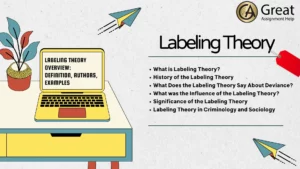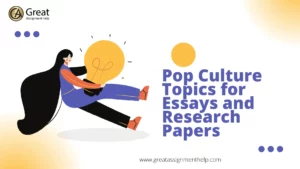In fields such as sociology and criminology, labeling theory is an important approach that helps to understand the nature of a crime. Would you like to get a profound knowledge of labeling theory? If yes, then take a look at this blog post. For your better comprehension, here, we have shared a labeling theory overview along with its definition, authors, and examples.
What is Labeling Theory?
According to the labeling theory, people develop identities and behaviors based on the labels that others give them. The sociology of crime has a strong association with this idea because it recommends that calling someone illegally deviant may have negative effects on behavior. For example, labeling someone as a criminal may lead to greater unfavorable treatment from others, which in turn may lead to the person acting out.
Also read: Best Graph Theory Project Ideas
History of the Labeling Theory
During the 1960s, Sociologist Howard Becker played a major role in flourishing the idea of labeling theory. But its fundamental concepts trace back to the work of French sociologist Emile Durkheim. Furthermore, its evolution was also influenced by the notion of American sociologist George Herbert Mead. His theory states that the social construction of the self as a process involves interactions with others. A few other researchers who contributed to the creation and study of labeling theory are David Matza, Frank Tannenbaum, Albert Memmi, Edwin Lemert, and Erving Goffman. To learn about the theories of these scholars, continue reading this blog.
Labeling Theory Overview: Definition, Authors, Examples
In this section, let us learn the definition of labeling theory, the works that influenced the labeling theory, and some comprehensive labeling theory examples.
The label theory proponents view deviant behavior as a process of interactions between deviants and non-deviants rather than as a set of characteristics that are inherent in people or groups. According to them, we need to identify why certain people are labeled as deviant to comprehend the original nature of deviant behavior.
Typically, those who possess the authority to apply the clear guidelines of conventional morality to others or who stand in for the authority of the law play a crucial role in providing labels. Moreover, labels that signify different categories of deviation are therefore an expression of the power dynamics inside society.
What was the Influence of the Labeling Theory?
As per the criminological literature, the following sociologists and their works influenced the labeling theory
“The Dramatization of Evil” by Frank Tannenbaum
According to The Dramatization of Evil, a person eventually turns into a criminal if he is described as one.
“Suicide” by Emile Durkheim
According to Emile, crimes and delinquencies are defined by how they offend society, not just by breaking the law.
Later, George Herbert Mead, John Dewey, W.I. Thomas, Charles Horton Cooley, Herbert Blumer, and others worked on the modern labeling theory. But out of all the scholars, Howard Becker played a significant role in the development of the modern labeling theory. Typically, this theory focuses on how society responds to the criminals’ actions.
According to the labeling theory, whether or not a conduct qualifies as deviant depends on how society views it. Labeling theory is classified alongside control theory, differential association, and symbolic interactionism.
Howard Becker’s Labeling Theory
In 1963 American sociologist Howard Becker discussed the Sociology of Deviance in his work “Outsiders.” He contends that being “deviant” is not inherent in a person; rather it was present inside the society.
According to Howard, society is classified into social groups, and individuals in positions of authority rule over these groups. As a result, they are the ones who are in charge of defining what constitutes deviance and shaping the criminal justice system’s definition of what constitutes a deviant.
In his work, Howard also talked about “Moral Panics,” or little instances that are exaggerated by the media, through rumors, or folklore to give the impression that something is threatening when it is not.
Labeling Theory Examples
Here, let us look at some examples of labeling theory.
Example 1: Marijuana
Jenifer suffers from acute anxiety and is aware of marijuana’s medical qualities. So she decides to get some medical marijuana.
She will have no trouble getting and consuming medical marijuana if she resides in Illinois, where it is legal. Even the folks around will not think of her behavior as a bad thing.
However, people will view Jenifer’s purchase and use of marijuana as deviant conduct if she lives in Wyoming, where it is unlawful to use the drug, whether for therapeutic or non-medical purposes. Since her behavior goes against social norms, they will label her as a deviant.
Example 2: Same-Sex Marriage
Ron and Ben are two men who love each other and wish to marry. As same-sex marriage is permitted in Massachusetts, they won’t have any trouble obtaining a marriage license if they reside there. Even their neighborhood will not view the same-sex pair as a deviant role. Their community will probably encourage and treat their marriage like any other.
On the other hand, Ron and Ben will face life in prison and punishment for “Buggery or Unnatural and Indecent Acts” if they reside in Barbados. Furthermore, their community will hate them and label them as “deviants.”
What Does the Labeling Theory Say About Deviance?
According to Erving Goffman’s dramaturgy theory, people utilize impression management to play their roles in society. Goffman considers each person to be a performer, and society to be the stage.
Deviance occurs when an actor unexpectedly acts out of character. It is described as behaviors that deviate from the norms of society.
According to Erwin Lemert’s “Societal Reaction,” a person’s social deviation progresses through two phases:
Primary Deviance
When someone behaves in a deviant manner or breaks social norms, it is considered primary deviation. However, there are no long-term effects, and the person’s self-perception remains unchanged.
Secondary Deviance
The person’s self-perception also gradually shifts. This label will serve as their “Master Status” or main persona.According to the labeling theory, a person gives in to their deviant identity when they are stigmatized as such by society.
Significance of the Labeling Theory
According to the labeling theory, no action is essentially illegal, which means that no action is ever criminal. For this reason, this theory is frequently used to understand criminal behavior or those who are labeled as deviants.
What constitutes a deviant act? Through the creation of laws, persons in positions of authority decide which actions qualify as such. These rely on the interpretation of the authorities who enact those laws, such as the police and courts.
According to this theory, deviation is the outcome of how society interprets criminality rather than an individual’s or group’s character.
Mental Illness and Labeling Theory
In recent events, individuals have become more aware of the importance of mental health. It results in the creation of a welcoming attitude by family members, friends, and employers toward the labeled individual who suffers from mental problems.
Walter Gove’s paper “Labeling Theory’s Explanation of Mental Illness: An Update of Recent Evidence” began with sociologists’ failure to account for psychiatric developments, resulting in a dispute between the use of labeling theory to describe mental illness against its psychiatric definition.
Gove further states that even if labeling theorists say that persons who have the label “mentally ill” are not distinguishable from those who are not, research reveals that there is a hereditary component that differentiates them.
Also read: Top Criminology Dissertation Ideas To Consider
Labeling Theory in Criminology and Sociology
Social sciences play a major role in labeling theory.
For instance, some may explain juvenile delinquency as the result of negative connotations attached to events or words that are normally viewed positively. To a non-deviant adolescent, the word “home” might represent warmth and family. However, if the juvenile has a strained relationship with his family, the term “home” takes on a completely other meaning.
This interactionist viewpoint aids criminologists in comprehending the behaviors and responses of a person.
Current Limitations of the Labeling Theory
Those who oppose the labeling theory claim that it
- Ignores socialization differences
- Disregard differences in opportunities
- Fails to put attitudes aside
Criticism of the Labeling Theory
The labeling theory continues to be a contentious issue that sparks discussions and disagreements.
Advantages of the Labeling Theory
Those who embrace the labeling theory view its advantages as follows:
- Makes the deviant behavior more understandable and in turn strengthens the structure of society.
- Assists in making accurate predictions
- Develops a comprehensive environment for people with impairments
- Improves communication for advocacy efforts
Disadvantages of the Labeling Theory
The following are some weaknesses of the labeling theory
- There is no empirical evidence that labeling causes more deviation. Despite its popularity in the 1960s and 1970s, the labeling theory began to erode as a result of mixed empirical research outcomes.
- Not everyone who engages in deviant behavior is labeled as such. For example, labeling opinions vary from state to state based on regulations enacted in that location.
Additional References
Listed below are some notable works from other sociologists, criminologists, and researchers about the labeling theory
- Crime and Community by Frank Tannenbaum (1938)
- Social Pathology, New York: McGraw-Hill By Erwin Lemert (1951)
- The Colonizer and the Colonized by Albert Memmi (1965)
- Criminology, New York (8th edition) by J.B. Lippincott (1970)
- Human Deviance, Social Problems and Social Control (second edition) by Edwin Lemert (1972)
- Labeling Theory and Criminology: An Assessment by Charles Wellford (1975)
- Learning to Labour: How Working Class Kids Get Working Class Jobs by Paul Willis (1977)
- Criminology, London: OUP Oxford by Stephen Jones (2009)
- Punished: Policing the Lives of Black and Latino Boys by Victor Rios (2011)
- Without Class: Girls, Race and Women Identity by Julie Bettie (2014)
Conclusion
Hopefully, by now, you will have gained a basic understanding of labeling theory. According to labeling theory, people may behave as per interactionism and others’ expectations of how to perform their roles in society. If individuals behave abnormally and experience both Primary and Secondary deviance, society will categorize them as such until their self-perception aligns with that label.
For students pursuing a degree in sociology or criminology, labeling theory is a good assignment topic. In case, you experience trouble with writing your academic paper on labeling theory, feel free to contact us.



